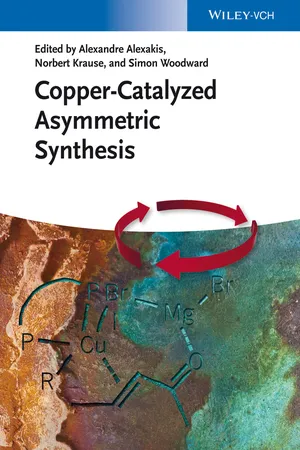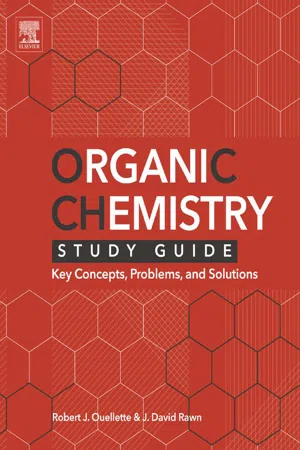Chemistry
Epoxide Reactions
Epoxide reactions involve the opening of a three-membered ring containing an oxygen atom. This can occur through nucleophilic attack by a variety of reagents, including acids, bases, and nucleophiles. Epoxides can also undergo ring-opening reactions with electrophiles, such as acids or Lewis acids.
Written by Perlego with AI-assistance
Related key terms
Related key terms
1 of 4
Related key terms
1 of 3
3 Key excerpts on "Epoxide Reactions"
- eBook - ePub
- Edwin Vedejs, Scott E. Denmark, Edwin Vedejs, Scott E. Denmark(Authors)
- 2016(Publication Date)
- Wiley-VCH(Publisher)
23Reactions of Epoxides (n → σ* )Tyler W. Wilson1 and Scott E. Denmark21 Gilead Sciences, Process Chemistry, 333 Lakeside Drive, Foster City, CA 94404, USA 2 University of Illinois, Department of Chemistry, 245 Roger Adams Laboratory, 600 South Mathews Avenue, Urbana, IL 61801, USA23.1 Introduction
The availability and versatility of epoxides elevates them as a highly valued functional group in synthetic organic chemistry [1]. Epoxides are readily prepared by the direct oxidation of olefins and tremendous success has been achieved for both diastereoselective [2] and enantioselective preparations of oxiranes [3]. In parallel with advances for their synthesis, strategies for the site- and stereoselective opening of epoxides have been developed that harness their strain energy for myriad transformations [4]. For example, the ring opening of epoxides with nucleophiles, which can proceed with clean inversion of configuration by an SN 2 pathway, allows the construction of vicinal stereogenic centers with high stereochemical fidelity. Taken together, these processes of epoxidation and nucleophilic ring opening provide an extremely powerful method for transforming simple olefins into diverse arrays of chiral 1,2-difunctionalized building blocks.23.1.1 Lewis Acid-Catalyzed, Enantioselective Epoxide Opening
The ability of chiral Lewis acids to catalyze the desymmetrization of meso-epoxides is now well established. Unlike most enantioselective transformations that involve enantiotopic face selection with compounds that contain no stereogenic centers, these reactions involve enantiotopic group selection with Cs -symmetric compounds containing two or more stereogenic centers. The power of this type of transformations is that a number of stereogenic centers can be unveiled in a single step (Eq. (23.1) ) [5]. The scope of the nucleophile for this process has evolved beginning with early studies by Nugent, who identified silyl azides as particularly effective nitrogen-based nucleophiles for epoxide opening using a zirconium alkoxide complex as the catalyst [6]. Later, Jacobsen greatly extended the field of meso-epoxide opening by employing chiral Cr- and Co-salen complexes for the reactions of epoxides with silyl azides, alcohols, and carboxylic acids [5a]. More recently, the scope of this process has been expanded to include phenols and sulfur-based nucleophiles by Shibasaki and coworkers, who described the use of a gallium–lithium BINOL complex as the catalyst [7]. These along with many other contributions have now made the Lewis acid-catalyzed opening of meso - eBook - ePub
- Alexandre Alexakis, Norbert Krause, Simon Woodward, Alexandre Alexakis, Norbert Krause, Simon Woodward(Authors)
- 2013(Publication Date)
- Wiley-VCH(Publisher)
As the epoxide ring, which is a particular kind of leaving group, is flanked by a double bond, the epoxides can be considered as a particular class of allylic substrates in which the allylic substitution is accompanied by a ring-opening process in which the leaving group is maintained in the final product. Hence, allylic epoxides combine the reactivity of epoxides and that of allylic substrates allowing a wide range of useful synthetic transformation, including reactions with nucleophiles and Lewis acid rearrangement processes [20–22]. In general, the regioselectivity of the ring opening of allylic epoxides with organometallic reagents depends heavily on the hard and soft properties of the nucleophile. It is generally admitted that hard alkyl metals attack under charge control, seeking the most positive center of the allylic epoxide situated in the allylic position (S N 2 addition). On the other hand, softer nucleophiles react through highest occupied molecular orbital (HOMO)–lowest unoccupied molecular orbital (LUMO) interactions, resulting in an orbital-controlled reaction (S N 2′ addition) [23]. In particular, organocopper reagents containing soft ligands are especially well suited for the S N 2′ addition to allylic epoxides [24]. In a S N 2′-type nucleophilic displacement, both the anti and the syn-stereoselective reaction pathway are, in principle, possible, but normally in a copper-catalyzed reaction, the anti -S N 2′ facial selectivity is largely predominant if not exclusive [24]. This preference, which has been qualitatively rationalized in terms of orbital symmetry [25], can be overridden when a particular chelating hindered group is present close to the reaction site. For example, Marino and Fernández de la Pradilla reported a sulfoxide-controlled S N 2′ displacement between cyanocuprates and chiral nonracemic epoxy vinyl sulfoxides 13a and 13b [26] - eBook - ePub
Organic Chemistry Study Guide
Key Concepts, Problems, and Solutions
- Robert J. Ouellette, J. David Rawn(Authors)
- 2014(Publication Date)
- Elsevier(Publisher)
The stereochemistry of the ring opening of an epoxide is easily predicted. Nucleophilic attack of a reagent such as methoxide ion occurs with inversion of configuration at the least substituted carbon atom. The stereochemistry of the other carbon atom of the original epoxide is unchanged because no bond to that center is broken in the reaction. In a substituted epoxide, the ring opening reaction under acidic conditions occurs by inversion of configuration at the more substituted center where the nucleophile attacks. The configuration at the least substituted center is unchanged.16.11 Reactions of Epoxides
The sulfur analogs of ethers are sulfides. They are named using alkylthio groups as substituents to the parent chain. Cyclic sulfides have common names.Sulfides are prepared by reaction of a thiolate, the conjugate base of a thiol, with an alkyl halide. Because the thiolate ion is less basic and is a better nucleophile than an alkoxide. The sulfur analog of a Williamson synthesis has fewer complications due to elimination reactions. Sulfide are oxidized to sulfoxides and then to sulfones.16.12 Spectroscopy of Compounds with C—O and C—S Bonds
Infrared spectroscopy is usually not used to confirm the presence of either C—O or C—S bonds because the stretching vibrations occur in a region complicated by other absorptions. The O—H stretching vibration of alcohols is easily seen as a strong broad absorption in the spectrum in the 3400–3600 cm−1 region.The chemical shift of hydrogen atoms bonded to the carbon atom bearing the oxygen atom of either alcohols or ethers occurs in the 3–4 δ region. The chemical shift of hydrogen atoms bonded to the carbon atom bearing the sulfur atom of either thiols or sulfides is less deshielded and occurs in the 2.5 δ region. Both O—H and S—H hydrogen atoms have variable chemical shifts depending on concentration.The a carbon atom of an alcohol or an ether has a chemical shift that reflects the deshielding of the electronegative oxygen atom. The deshielding due to a sulfur atom is smaller.
Index pages curate the most relevant extracts from our library of academic textbooks. They’ve been created using an in-house natural language model (NLM), each adding context and meaning to key research topics.
Explore more topic indexes
Explore more topic indexes
1 of 6
Explore more topic indexes
1 of 4


